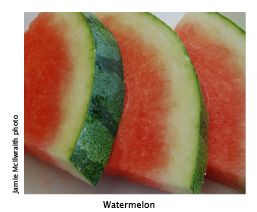Watermelon growing tips & recipes
Growing tips: watermelons need space to grow, a sunny spot (at least six hours of sun a day) and plenty of moisture, a rich soil and a warm, frost-free climate, the warmer the better. Go easy on the nitrogen-rich fertilisers (like blood and bone or Nitrosol) or you’ll get a very big vine with few fruit. In temperate zones, sow seed in spring (but seeds won’t germinate when temperatures are below 15°C). In temperate zones, you can sow seed from September until December, so it’s not too late to get started. In subtropical zones you can sow seed from September until January.
Sowing seed: sow seed in clumps of 4 or five seeds, let them germinate and when seedlings are growing well, pick out and discard the weakest plant and let the strongest one or two grow on. If you have no space problems and want to set up a real watermelon patch, sow clumps 5m apart.
Growing tips: young plants need lots of water, but once fruit starts to mature it needs less water. When flowering starts, give plants a feed with citrus food (eg, Dynamic Lifter for fruit & citrus), and keep on feeding every four weeks. Mulch the ground around plants to retain soil moisture.
Harvesting: harvest in mid to late summer, about 12-16 weeks after planting seed. To save space, pinch out the terminal tips of the vine’s runners when they’re about 2m long, and this will limit their spread.
Baby melons: new baby watermelons are available as seedlings and seeds now. These plants grow only about 1.2m wide and produce much smaller fruit. A choice of flesh colours (yellow, orange and red) is also available in baby melons.
Harvesting tips: watermelons are ripe when they have grown to full size, when the underside of the melon changes colour from green to light yellow, and when the fruit gives off a hollow sound when you tap it with the knuckle of your hand.
Problems: the fungal disease powdery mildew can occur in humid summers, so routinely spray plants with a mix of one part milk to nine parts water. Do this every week, and repeat sprays after it has rained.
How do they grow seedless watermelons?
In his article on melons in the March 2008 issue of Burke’s Backyard magazine, botanist Peter Valder explained how this is done:
“Ordinary watermelons have two sets of chromosomes in each of their cells, but by using chemical techniques plant breeders have produced kinds with four sets of chromosomes. If you cross-pollinate these two kinds you get seeds which give rise to plants with three sets. Such plants are sterile and can produce no viable pollen and no seeds (or just a few soft, white, empty ones). However to get them to produce fruits you must have the ordinary kind growing nearby so that its viable pollen can be used to pollinate the flowers of the sterile kind. So this is hardly a proposition for the average home gardener.”
Watermelon & Lime Granita
Serves 8-10
1 cup (220g) caster sugar
1 cup (250ml) water
3kg watermelon
3 tablespoons lime juice
1. First make a sugar syrup by adding the sugar and water to a saucepan, stirring over low heat until the sugar dissolves. Bring to the boil, reduce heat and let it simmer for 10 minutes. Let it cool completely, then put into the fridge until cold.
2. Cut all the flesh from the watermelon, discard the seeds, then chop. Put into a good processor and puree, then put into a sieve over a bowl and let the juice drip through (press down on the pulp to extract more juice.)
3. Stir the cooled sugar syrup into the watermelon juice, add the lime juice and stir well. Now put this mixture into a container and put this in the freezer. After two hours, take the container out of the freezer, and whip the half-frozen mixture, to break up the ice crystals. Do this two or three more time, every 2 hours. The more you do it the lighter the granita will be. Leave overnight to freeze completely, then serve on its own, or with in-season fruits such as fresh berries.



